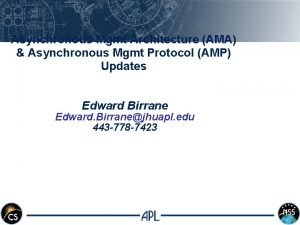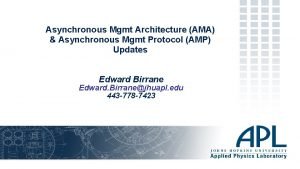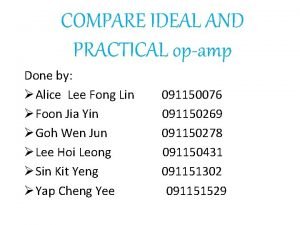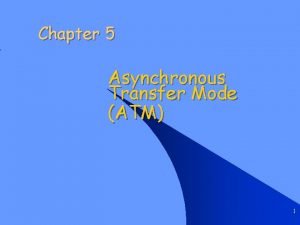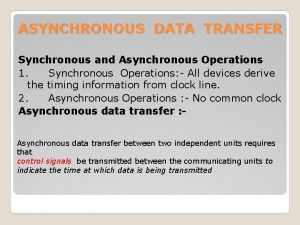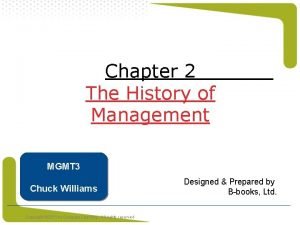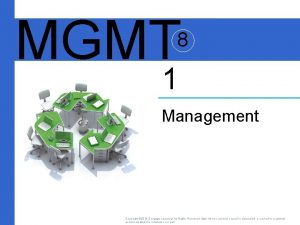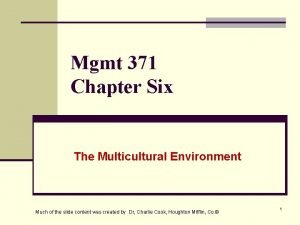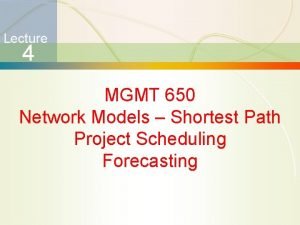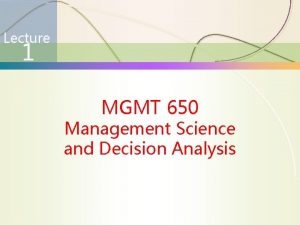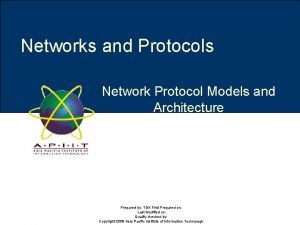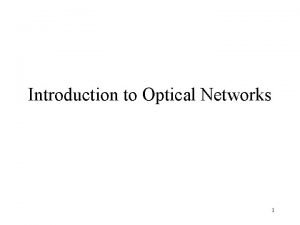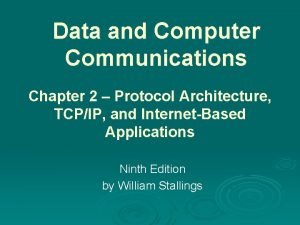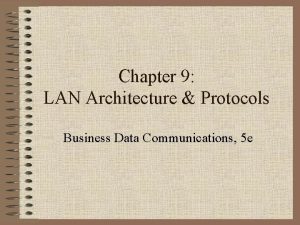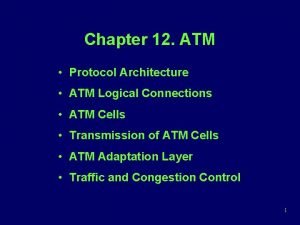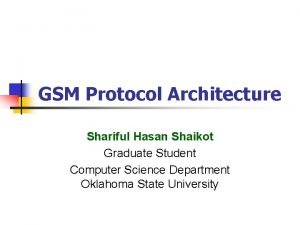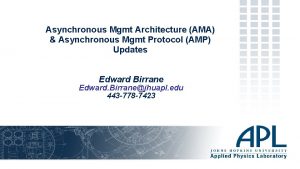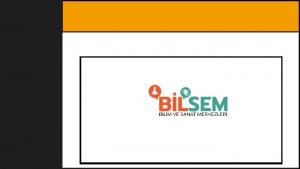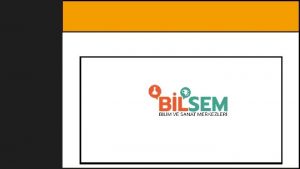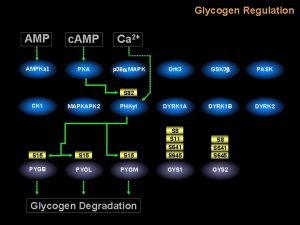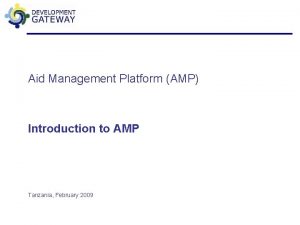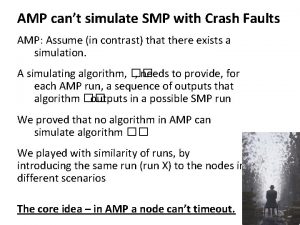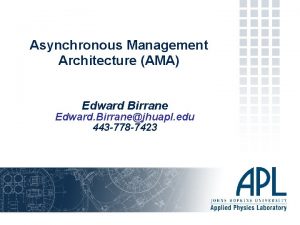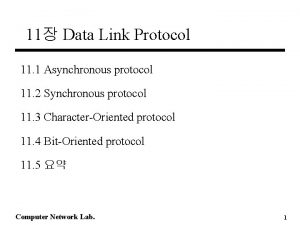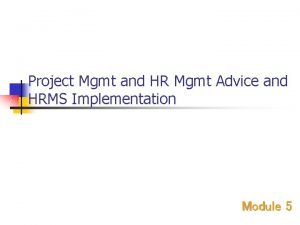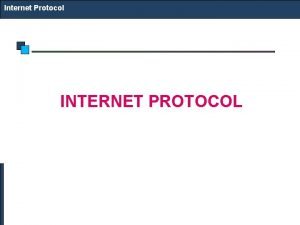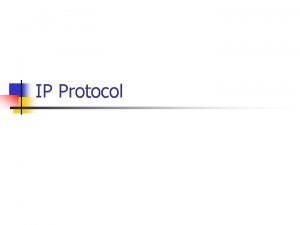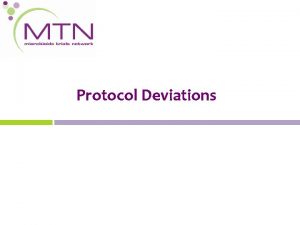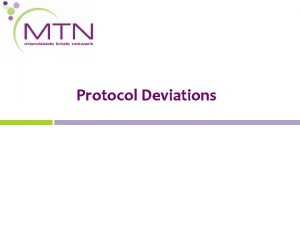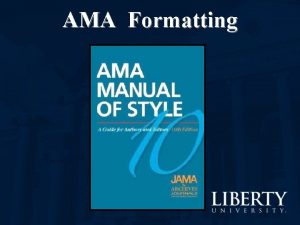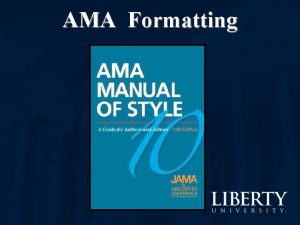Asynchronous Mgmt Architecture AMA Asynchronous Mgmt Protocol AMP


























- Slides: 26

Asynchronous Mgmt Architecture (AMA) & Asynchronous Mgmt Protocol (AMP) Updates Edward Birrane Edward. Birrane@jhuapl. edu 443 -778 -7423

AMA: Overview From draft-birrane-dtn-ama-03 § Service Definitions q q Configuration: Change settings on an Agent. Reporting: Receive performance information from an Agent. Autonomous Parameterized Control: Change Agent Behavior. Administration: Fine-grained access to abilities. § Desirable Properties q q q Intelligent Information Push: Can’t rely on others. Minimize Message Size: Increase probability of delivery. Absolute Data Identification: pre-shared, global naming when possible. Custom Data Definition: Only send minimal necessary data sets. Autonomous Operation: Decisions local to Agent based on its config.

AMA: System Model § Agents q q q From draft-birrane-dtn-ama-03 Run on Managed Devices Configure/Report on devices Heavy autonomy and parameterized control § Manager(s) q q q Collect/Fuse data from Agents Configure Agent behavior Open-loop control § ADMs q q Well-named Data and Controls Superset of MIB Move to describe them in YANG Preconfiguration reduces msg size

AMA: App. Data Model (ADM) § “Atomic” Elements q q q Solely defined by their ADM. EDDs: collected by agents. Literals: useful constants. Ops: opcodes for math functions. Ctrls: opcodes for agent behavior. An ADM defined 8 types of data for each application/protocol managed in the AMA. § “Variable” Elements q q q Defined by ADM or by User ADM definitions are immutable. Vars: strong-typed variables, including a type for “expression”. Macro: Ordered set of Ctrls. Rpts: Ordered sets of data Rules: Time or State based autonomy.

AMA: Updates From -02 to -03 § Minor Terminology and Definitions Updates q q q Mostly wordsmithing based on feedback. Clarify distinction between a Report Template, a Report Entry, and a Report as a collection of entries. Some expanded text around parameterization and motivation for the approach. § No significant issues or limitations with the architecture. q No “structural” changes to the architecture. § Primary focus has been on AMP and associated ADMs.

AMA: TODO Propose AMA provides the architecture and required functions of a DTN Network Management Protocol. § Some discussion of terminology q q q Atomic Data vs. Primitive Data vs. Externally Defined Data Computed Data vs Variables Specs out of sync on terminology. • Need a refresh across related drafts to synchronize them. § OPs AD feedback q q Reviewing RESTful NETCONF and YANG Push models Review to date does not seem to change the AMA. • May also not change the AMP, which is considered separately. § Request AMA be considered by the WG when it is time to address Network Management for DTNs.

AMP: Overview AMP being evaluated by space and non-space users. NASA providing an opensource reference implementation in ION. § Protocol conformant to the architecture/requirements of AMA. q q Implements Agents, Managers, ADM structures. Defines specific data models to implement AMA structures Defines messages to capture AMA controls/reports/administration Defines on-the-wire encodings § Data Models q q Basic Types: Numeric types, strings, etc… Compound Types: BLOBs, (Typed) Data Collections, Tables, Identifiers, Collections, Expressions, Predicates § Functional Specification q q AMP Message Groups: Common headers and trailers Three messages: Register. Agent, Perform. Control, Data. Report

AMP: Updates (1/2) From -02 to -03 § Minor Terminology and Definitions Updates q q Wordsmithing based on feedback. Reduced redundancy between AMP and AMA specs. § Clarifications q q q q Clarified Report Templates vs Report Entries vs Reports. Clarified State vs Time-based Rules. Corrected AMP Epoch time. Added rationale for design of TDCs. Clarified that OID Nicknames are registered values. Clarified OID Parameterization Approach Clarified definition of Variables and their initializing expression.

AMP: Updates (2/2) From -02 to -03 § Additions/Updates q q q q Added Table AMP structure. Added Result Type to Expression structure. Added required levels of Macro nesting. Updated type enumerations. Added allowed numerical promotions Added rules for numeric conversions Updated format of Data. Report message. § Removals q q Removed draft design of N of M counts for SRLs. Removed enable/disable from SRL and TRL structures

AMP: TODO From -02 to -03 § Upcoming Spec Changes q q q How best to add N of M and enabled/disabled to SRL/TRLs Change TDC column IDs to be of any type, not just string. Add Access Control Lists (ACLs) and describe behavior. Transition to CBOR for encoding. Add guidance in ADM section on when to define TABLEs versus EDDs vs Controls that return data. Should AMP specify a wire encoding? § More Review from Reference Implementations q q Continued support of reference implementation efforts At last count there were 4 separate implementation efforts • Discussions on 2 additional efforts.

AMA/AMP Related Specifications § Core Specs q q AMA: draft-birrane-dtn-ama-03 AMP: draft-birrane-dtn-amp-03 § ADMs q q AMP Agent ADM: draft-birrane-dtn-adm-agent-02 BPSEC ADM: draft-birrane-dtn-adm-bpsec-00 BP ADM: draft-birrane-dtn-adm-bp-00 YANG profile for ADMs: draft-bsipos-dtn-amp-yang-01 § Other: q AMP Manager SQL Schema: draft-birrane-dtn-ampmgr-sql-00

Current Status NASA building out AMP for deployment to ISS and other infusion targets • Reference implementation in ION open source this year. – • NASA supporting AMA/AMP ongoing work • • Writing ADMs for BP, BSP, CGR, LTP, and ION. Several non-NASA efforts ongoing. • • Supporting AMP protocol messages, Agent, BPSEC ADMss. AMP is not directly tied to BP or DTN, though it is very helpful for DTN use cases. Finalizing AMA and AMP specs for consideration in DTNWG – – As novel intersection between performance monitoring and safing autonomy Meeting with OPS AD people as they are identified to discuss AMP vs RESTful NETCONF and YANG Push.

Backup

AMP: Key Concept: MIDs Every AMP structure identified and parameterized by a Managed Identifier (MID). § Concept q q q Every AMP structure is identified by a MID. Simplifies processing. Hardware acceleration. § Issuer/Tag q q q MIDs defined in ADM. have no Issuer/Tag. User-defined MIDs must Control MID: Generate Agent ADM Report have issuer ID. 0 xc 304010903021517050182030100020100 Tags always optional. Control MID: List VARs known to Agent § Parameters q 0 x 83040103 Var. MID: User-Defined UINT variable. Captured in the MID itself. 0 x 110103010203

AMA Roles and Responsibilities

AMA Basic Data Flow

AMA Multi-Manager Flow

AMA Data Fusion Flow

Compatibility with existing mechanism § SNMP Uses OIDs as IDs § Global, Managed Tree Structure § “Path to data” is concatenation of #s. § if. Speed = 1. 3. 6. 1. 2. 2. 1. 8 § Supports Binary Encoding (BER) § Compress first 2 #s: 1. 3 => 43 § SDNV-encode rest § SNMP Identifier: <type> <length> <value> § Type 6 -> OID § Length (in this case) = 9 bytes § if. Speed = 0 x 06092 C 060102020108 § AMP Uses MIDS (Managed IDs) § MIDS encapsulate OIDs (less <type> field) § Option to compress OID § Makes easy to interoperate with SNMP

OID Types (1/2) – Full OID – – Length + Octets Not interpreted by AMP. Used as a unique bitstream. Encoded in ASN. 1 BER for now, assuming SNMP Type 6. Parameterized OID – – Full OID followed by AMP Data Collection (DC). DC is a count followed by a series of TLV. – – Time, Length, Value Type is data type (string, int)

OID Types (2/2) – Compressed OID – AMP supports managed registry of common OID sets. – – Nickname is an integer that maps to a well-known node in an OID tree. – – OIDs can be very long and the portion up to your relative subtree can be reused a lot. Relative OID is subtree rooted at that node. Compressed, Parameterized OID – – Compressed OID followed by a Data Collection of Parameters Very similar to a Parameterized OID.

Application Data Model AMP ADMs capture all necessary information for each supported application or protocol. . • Atomic Data and Controls. – – – Literals and Operators. – – – What constants are defined for this application? What special operators can be used to compute new data definitions? Computed Data. – – What immutable data definitions are given for any manager/agent supporting a particular application? What common actions can be taken to manage this application? What data definitions are pre-derived from other data definitions? Collections. – What pre-defined collections of data values (reports) and control sequences (macros) have been created?

ADM Example (1) Pre-defined data, reports, and controls for applications managed by AMP. § Pre-defined, atomic data § Definitions from MIBs § Global, unique OIDs § No tag/issuer fields § All data and reports § Build blocks for user content § Data MIDs can be used in user definitions § Pre-defined controls § Also global, unique OIDs § Opcodes, description, params § Build blocks for macro commands § No ability for user-defined controls outside of these pre-defined functions. Bundle Protocol ADM Atomic Data Reports MID 1 = Expired. Bundle. Count MID 5 = MID 1, MID 2 = Custody. Accept. Count MID 6 = MID 5, MID 3, MID 4 Computed Data Controls MID 3 = MID 1 + MID 2 MID 7= Clear. Bundle. Cnt() MID 4 = AVG(MID 3, 10 s) MID 8 = Clear. Accept. Cnt()

ADM Example (2) A sample ADM for an application implementing a stack.

AMP Agent ADM From draft-birrane-dtn-adm-agent-00 § Captures all behavior of an AMP Agent q q Keeps AMP functional specification simple Items available to AMA/AMP ecosystem because this ADM must be implemented by any deployed AMP agent. § Primitive Values q Counters, number of AMP types created, active, etc… § Reports q Full report definitions. Users may customize their own. § Controls q All functions to create, update, delete, and other wise manage reports, rules, macros, and other AMA types. § Operators q Full math function spec • +, -, *, /, %, ^, &, |, &&, ||, !, abs(), <, >, <=, >=, !=, ==, >>, <<

Thank you! Questions? 26
 Mgmt ama
Mgmt ama Mgmt ama
Mgmt ama Difference between ideal and real op amp
Difference between ideal and real op amp Connections in asynchronous transfer mode are called
Connections in asynchronous transfer mode are called Dma timing diagram
Dma timing diagram Infrastructure mgmt
Infrastructure mgmt Tim washington portfolio management
Tim washington portfolio management Chapter 2 history of management
Chapter 2 history of management Mgmt 4
Mgmt 4 Mgmt 371
Mgmt 371 Mgmt+8
Mgmt+8 Mgmt 371
Mgmt 371 Keller graduate school of mgmt
Keller graduate school of mgmt Mgmt 341
Mgmt 341 Mgmt 371 final exam
Mgmt 371 final exam Mgmt 650 quiz 4
Mgmt 650 quiz 4 Mgmt 650
Mgmt 650 Mgmt 411 purdue
Mgmt 411 purdue Security architecture for the internet protocol
Security architecture for the internet protocol Network protocol architecture
Network protocol architecture In a telecommunications network architecture, a protocol is
In a telecommunications network architecture, a protocol is Protocol architecture
Protocol architecture Network protocol architecture
Network protocol architecture Anisha patel md
Anisha patel md Lan protocol architecture
Lan protocol architecture Atm protocol architecture
Atm protocol architecture Gsm protocol architecture
Gsm protocol architecture
